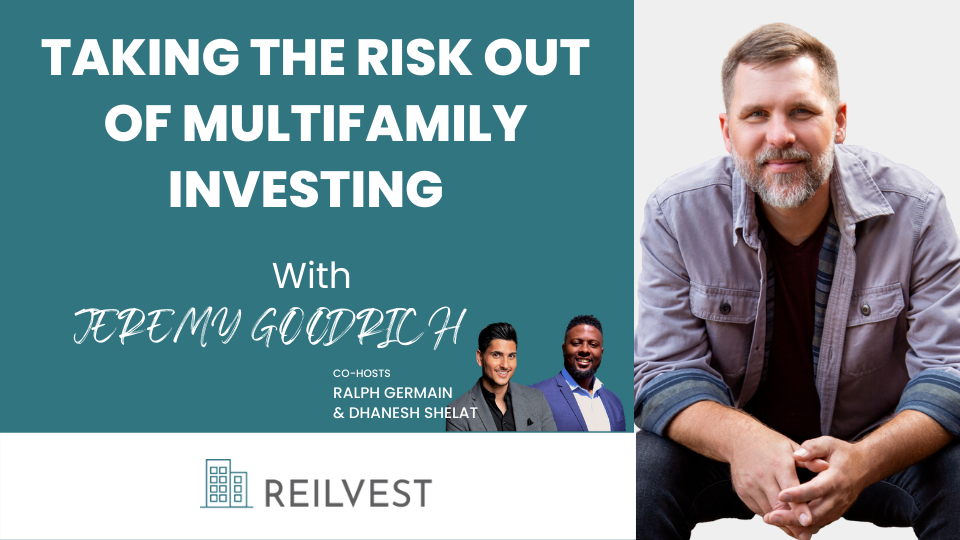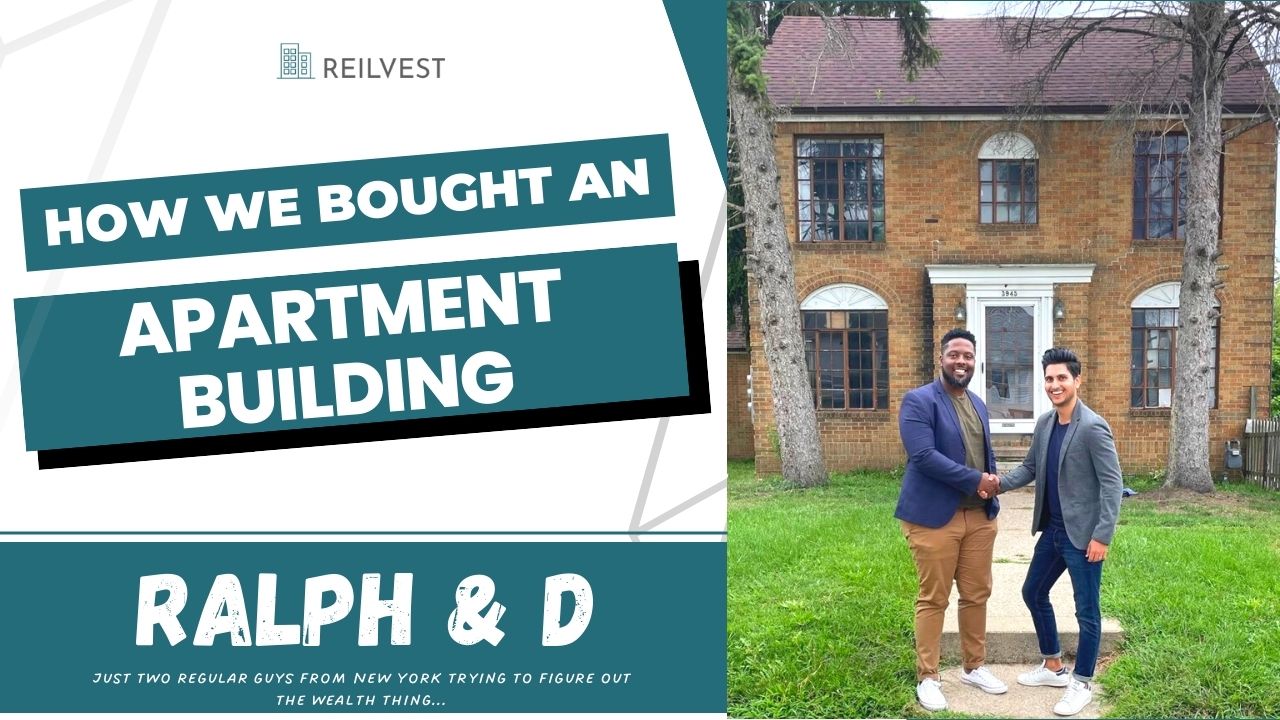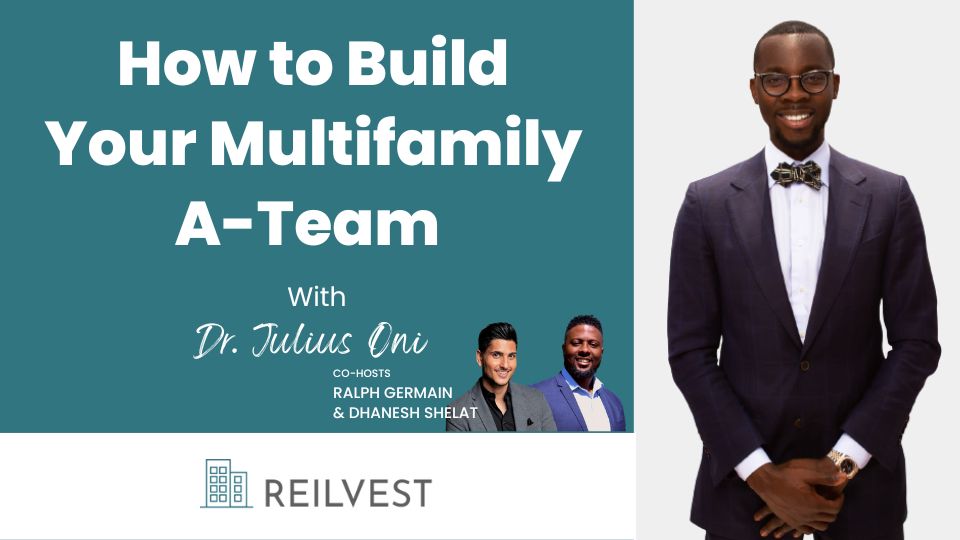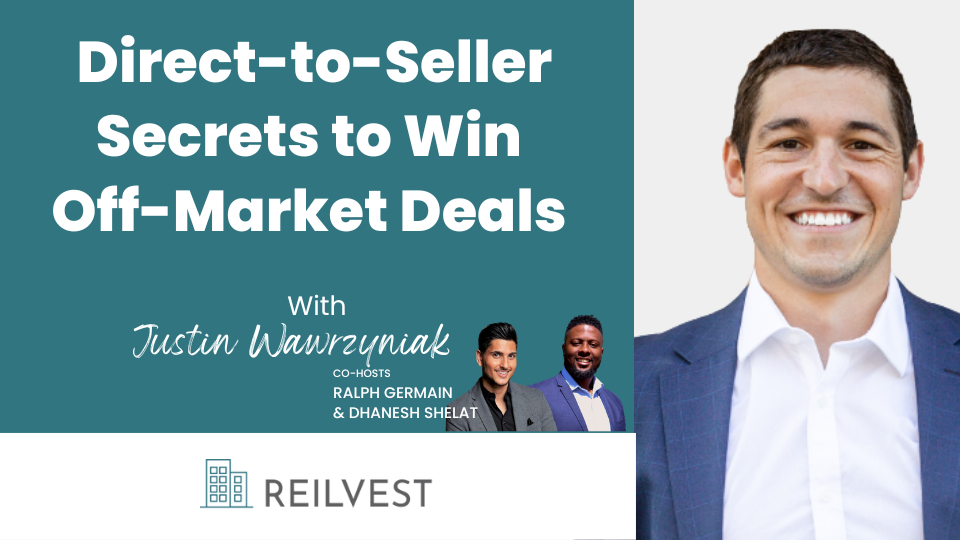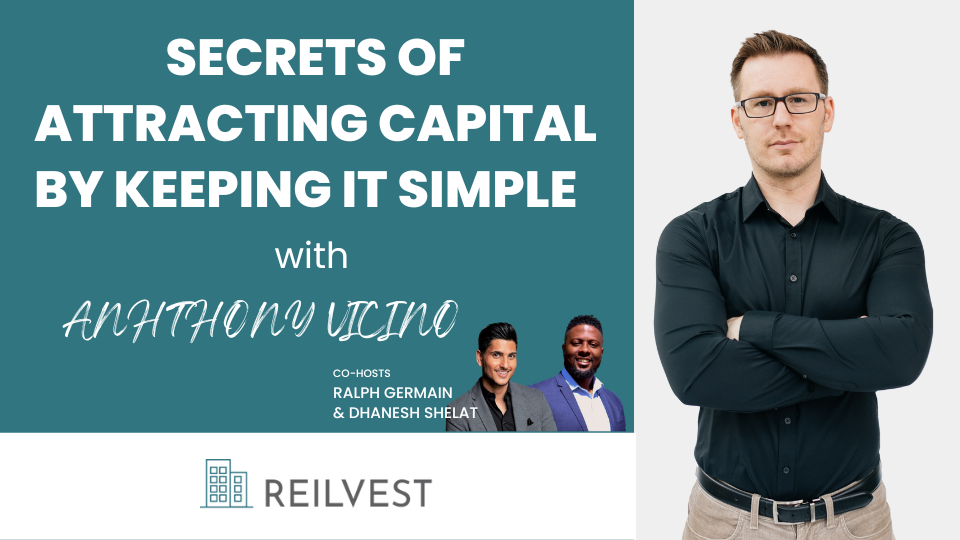Jeremy’s been on the journey with hundreds of commercial real estate investors helping them manage risk and get clarity around their strategy. As the host of the most-watched insurance agency channel on Youtube, Jeremy shares stories & answers questions in a way that actually makes sense and is interesting.
KEY TAKEAWAYS:
-
- The 3 key elements to risk: identify it, understand it, manage it
- Assessing the skills and track record of the operator/sponsor is fundamental to Jeremy investing passively in deals as a limited partner (LP).
- The 3 E’s to running a successful business: ducation, experience, entourage
TRANSCRIPT
Dhanesh: All right then, Ralph. So who do we have this morning?
Ralph: Yeah, very excited. I think there’s going to be a good treat, I guess, for folks thinking about investing. And we’re going to really spend some time talking about risk. And not just insurance, but just some general risk. I think our guest today is going to have some good insights, not only about insurance and multifamily property, but also can share a lot as an LP, about what to expect as an investor. So I think I’m excited here. So our guest today’s Jeremy Goodrich, and we’re looking forward to getting right into it with some good questions.
Jeremy: Hey, thank you, Ralph. Thanks for having me.
Ralph: Jeremy. Thanks for joining us here. I know you are traveling, but still made time to be here. So we’re very excited to have you. Maybe you could start by just telling us a little bit about yourself and how you got into multifamily.
Jeremy: Absolutely. Can you hear me okay?
Ralph: Yeah. Coming in loud and clear. Perfect.
Jeremy: Cool. So, I really identify myself as what I was for a large part of my adult life before coming into this side. And that was teacher. I was an elementary school teacher, third and fourth-grade school teacher for 13 years before joining the insurance world. And then multifamily really came pretty quickly after that. So when I left teaching and started my own insurance agency, Shine Insurance, my intention was to change the way people feel about insurance. It’s like this thing that we kind of hate, but we know we have to have, and it’s this big expense and all those kinds of things. And I can’t change a lot of that, but I can certainly make sure that at least it’s understandable. At least it makes sense why I have it in my multifamily journey. And at least I can make sure that piece of the puzzle is fulfilled by a smart team member and someone who actually cares.
So that’s kind of where I was coming from. And I just started creating videos on how to invest in real estate. Started with first-time home buyers, so literally investing in your own home. And then it was how to invest in single-family homes, and residential real estate. And then after that, really all I do now is commercial real estate, both on the insurance side and talking about risk and on the YouTube channel. It’s really about commercial real estate, how to purchase and protect your properties. And so, it’s just always been a passion of mine. Through that process, as an insurance advisor, I obviously see a lot of deals. I see a ton of deals. I see OMs every day, proformas and things like that. I’m constantly reviewing properties.
And so it made sense to get in as a LP investor in some of these deals. And so now my active cash flow. I feel like everyone has to have an active cash flow and a passive cash flow. You’re bringing money in through actively doing things. And then you’re taking some of that money and putting it into whatever it is. But obviously, real estate is a great place to go. And so, my active cash flow is the insurance agency. And my passive cash flow is the LP investments.
Ralph: Yeah. Awesome. First off, I know you as an elementary school teacher, that’s not an easy job. So I always wonder, what do you find easier, real estate or teaching third or fourth grade, as you said?
Jeremy: Yeah. I mean just drastically different things. It’s so funny. Families dropped their kids off and trusted me with them. And I always understood that and really took that responsibility seriously, and had a great time with the elementary kids. And it was a fun time. I loved being a teacher. I love teaching kids how to love things, how to love reading, how to love writing a story, how to love even math. I mean, we had these business projects where they would invent a business and it didn’t have to make any sense at all. They could sell rainbows or planets or all sorts of stuff. And then everyone would buy it from each other and we had this entire ecosystem of these just like crazy things that people were selling. So I always just tried to make it interesting and fun.
Switching over to real estate and insurance, it’s hard in different ways. People suddenly don’t trust you. People suddenly think like, oh, what’s he trying to do? Or whatever. And so there’s a difference there. But I enjoy both of them. I enjoy being a teacher and I love what I’m doing right now.
Ralph: Yeah. Awesome. And I love, you talked about having active cash flow and also passive cash flow. And we all know, that’s probably why everybody’s here. The reason why passive cash flow is so important is because that’s really the route to financial freedom. But a lot of folks get a little bit nervous to make that leap into passive investing, because you have less control. And I think one of the things that stops people because their idea of not having control over their investment once they’re passive, is the idea of the amount of risk that they can tolerate. So can you talk a little bit about what are some of the biggest risks you’ve seen as an insurance broker in the multifamily investing, and some things that newer investors may not really be thinking about or considering right now?
Jeremy: Yeah, so I think that on the risk piece, the most important thing you can do is understand how to do three things with risk. One is identify risk. The second is understand it. And the third is to manage it. And I’ll tell you a very quick story to get this point across. So my wife went to Daytona Beach, kind of close to where, Dhanesh, you are right now, I think, in high school, on a spring break trip. We’re from the Midwest. You drive down to Daytona Beach in spring break.
And the first day they went out, one of her buddies, his name’s Rodney, comes out and this is kind of a big Irish dude, sort of a Chris Farley type of guy. Comes out with this large gallon sized jug of suntan lotion and says, “Hey, I’ve got this great big jug of suntan lotion. I went across the street from the hotel room, went to the convenience store, and there was a bunch of more expensive lotion. There was $7 lotion and $10 lotion, even $15 lotion. But in this entire gallon jug was $2. And I’m so excited to have it.” Had it all day. Was lathering it on. Rodney wasn’t really someone who put on suntan lotion a whole lot. But man, when you get a $2 gallon jug, you are putting on that sun lotion all day, trying to share it with people. And no one wanted to. Everybody else was like, “Dude, Rodney. I don’t know, $2 gallon jug of suntan lotion.”
So all day goes by. And of course, by the end of the day on the beach, there’s only one person who is absolutely burnt to a crisp and is a lobster. And that is Rodney. Kind of ruined his spring break. It was something he had to deal with the whole rest of the day. So what’s the lesson there? Well, Rodney identified a problem. He identified a risk. The risk is getting sunburn. And he understood the risk well enough to say, well, how can I manage this? And his solution for managing the risk was the problem. He said, well, I’m going to go out and buy the cheapest bottle of suntan lotion. And of course, that didn’t actually solve the risk for him.
So I think, as you’re investing in commercial real estate, it’s much more complicated than the sun. We know if we go and sit out on a beach for an entire day, that there’s a risk of getting sunburn. But when you get into a commercial real estate property, maybe a multifamily property that’s 150 doors, and you’re thinking about picking it up, there’s a lot to navigate there. And I can dig deeper into that piece. But I think if we’re constantly figuring out how do we identify, understand and manage the risks associated with the property, then we’re going to be in good shape.
Ralph: Yeah. I love that. So that’s the three things, identify, understand, manage the risk. And I think, like you just mentioned with that great story, and I feel bad for your buddy, Rodney. But you know what?
Jeremy: He turned out okay. It was just sunburn.
Ralph: Yeah. I mean, but lesson learned. But you know what, you can apply that same method to multiple things in life, right? To not just risk and investing in real estate, but just overall risk of certain decisions that you’re making. Identify, understand, and then manage. Those are three tiers. I love that. What are some of the things you look for as a passive investor that’ll help you make an investing decision?
Jeremy: Really one thing. And I think that, I mean, there’s more behind it, but it really is the sponsor. It’s the operators, it’s the team. So when I’m looking at a deal, I want it to be in a market that I feel comfortable with. I underwrite, on a surface level, the deals I’m thinking about getting in on passively. But I just got in a deal. And again, I do the insurance on a lot of these, so I am underwriting them from just a different perspective. But it’s just a sponsor. Do I trust the business plan of the people that are doing the actual work, who are actually going to be the asset manager, who are actually operating the property, who actually built the business plan in the first place.
If I trust them, everything else falls into place. If they’ve done a bunch of deals and made money off of those deals, then I can trust that history that they have and dig in there. So I’m not saying I invest blind. That’s not what I’m doing, but I’m looking at deals. But certainly, what matters most to me is the success ratio of the people who are investing. And so I think for folks who are here, if they are capital raisers or people who are new to the business, and you’re listening to me say that, and you’re saying, well, how can I raise any money because I haven’t done deals before? I really think that, and Ralph, you can tell me if you agree with this, but you have to align yourself with people who have experience. There’s just no doubt that experience matters when people are handing over $100,000, $200,000 of their money.
So if you don’t have experience, that’s okay. But you have to be able to tell someone who’s going to hand you the money, “Look, I may be new to this process, but here are the people who are actually going to do the business plan. Here’s the history they have. Here’s what they’ve done in the past. Here’s what their deals have brought to their investors before.” And I think that’s a great way to get started. You don’t have to have the experience, but you have to have someone who does.
Ralph: Yeah. I love that. Exactly. I mean, the old of moniker always goes, “People do business with people that they know, like and trust.” So initially, the reason why someone will invest with you as a syndicator, as a multifamily syndicator, is not just because of the deal or just because of the experience, but because they know, like, and trust you. So it doesn’t make sense if you’re a newer syndicator to lie or make up something about your experience. It’s better to be trustworthy and say, “Hey, listen. I am new to this, but I’m working with someone who has a lot of experience.” And really ride their experience. And that relationship, that transparency, I think, does volumes for your business.
Jeremy: Yeah, the biggest risk you’re taking as really any investor, but certainly as a passive investor, is losing that cash, losing the capital that you had before. You certainly want to make money off your capital, but what you don’t want to do is lose the money you had in the first place. And so, to mitigate that risk, to manage that risk for passive investors, you’ve got to have a business plan that makes sense. You’ve got to have experience and a history that you’ve succeeded before. And you have to have a story, I think, of a failure or an almost failure where, what happens when something goes sideways, when COVID hits in March of 2020? The examples that you have of how you handled something that went sideways are really, really important.
I have a client right now who purchased a property, and like two weeks after purchase, one of the buildings went entirely down in a fire. Now, nobody was injured. So that’s good. But she now has some adversity. How did her insurance hold up? How did the process go? How was the business plan able to fulfill itself even after adversity happened? I think that answers another key question.
Ralph: Yeah. For sure. How can someone who’s new, a new investor, but they’re trying to invest passively or actively, how can they identify risks before investing? What are some of the things that they should look for? We know the sort of like philosophical or emotional connection to the group that’s syndicating, know, like and trust. But when you’re looking at the deal itself, how can they look at the deal and it’s underwriting or the offering memorandum and try to understand some of the risks involved in that?
Jeremy: Yeah. I think the best answer is from the active investor perspective, because as a passive investor, if you’re going to dig into the deal, you’re essentially doing a surface version of the same thing an active investor would do. So step one to managing risk is you’re underwriting, you’re penciling the deal, you’re proforma. When you’re trying to decide whether to submit a letter of intent or go forward with something, that is your first layer of managing risk, you’re trying to find, you’re trying to identify where the risks are. Is there a risk that the price of the property is too high? Is there a risk that there hasn’t been renovations or things that you’re going to have to invest capital into? Is there a risk that you won’t have tenants that you think you’re going to have because of the market or whatever? So the first layer is really that proforma work, that underwriting work.
And then the second layer obviously is, once you’re into due diligence. And so, a common example of identifying risk. That’s all due diligence is. It’s identifying, understanding and figuring out how to mitigate risk. And so something like, are you going to check the sewer lines and see if those lines do a line check or whatever you call that. There’s a cost associated with that. Sometimes during due diligence, people don’t want to do it, but there are lots of terrible examples of getting into a property and finding out that you have tens of thousands of dollars of cost in redoing a sewer line because you didn’t snake it while you were doing due diligence.
So how we mitigate risk is by analyzing the deal. That could be in the front end, with the proforma, looking at all the parts of the deal. And everybody’s got different proformas and different ways to go about that. And then due diligence, making sure you have your checklist, making sure you have people with experience in the mix doing due diligence with you and walking through that. I don’t know if that was too surface or not, but those are the two places when managing risk.
Ralph: Yeah. That’s good. I had another question here. So despite being so close to the mechanics of a deal, what were some of the drivers that had you want to still remain as a passive investor, as opposed to jumping in on the active side of putting a deal together?
Jeremy: Yeah. I have no interest in being an active investor. I’m a service team member to the commercial real estate world. That is the active thing that I do. When I see people who are lenders and active investors or insurance agents and active investors, certainly, people can do it. But I don’t understand how. Being the insurance advisor, the service team member is what I do. That’s the active thing that I do. So for me, passive investing in real estate is really the only avenue unless I wanted to quit my day job and close down my insurance agency. And that’s not something that I want to do.
Ralph: Yeah, it makes sense. It reminds me of the Gary Keller book, which I’m sure folks have read, One Thing, really just focusing on the one thing and doing that well. And there are still plenty of advantages and opportunities to still reap all the benefits that active investors do by being a passive investor as well. So that’s still good. Jeremy, I have another question here, what are some of the things that would surprise folks, in the world of insurance, that would surprise a new investor or a new multifamily syndicator that they’re not considering when looking at a deal that you find, that’s very common in your field where you’re looking at it a lot, but for some reason, new investors are not necessarily thinking or looking at it when it comes to insurance and insuring their property?
Jeremy: Yeah. And just to transition from where we were at before. Insuring property is managing a certain risk. And that is managing your property risk. We’re managing the physical risk of the place. So what are some of the big things I’m seeing? I mean, the insurance world right now, especially in multifamily, is very interesting. And prices seem to be going up. Certainly, Texas right now is a little bit of an insurance mess because of the winter storm, Uri, and what was going on there. And so, the biggest mistake I see people making with insurance is to go to four brokers, have them all send you quotes. You try and figure out what’s what, you try and figure out what makes sense. Then you realize you don’t get it, because you’re not an insurance advisor. And so you do the wrong thing. You pick the cheapest policy.
Usually, the cheapest policy is not actually the cheapest policy. It may have the lowest price, but there’s usually some things that are cut out from that. And if you talk to the person who actually cared about you, who actually was trying to protect that property in the right way, they could say, “Well, yeah, I could get down to that price. I could probably get below that price. But you don’t want me to do that. And here’s why.” And then they articulate the quality that they have in the policy.
So I think the biggest mistake people make with insurance, I mean, I say about 80% of real estate investors have policies that won’t take care of them like they think it should. And every single one of those is the same reason, is you went and you got the cheapest policy you could because you looked at the policies and it didn’t really make a lot of sense, and then you have a fire and you realize that policy wasn’t as good as you thought.
Ralph: Yeah, very true. And you know what, it’s really like buying the $2 jug of suntan lotion, right? Like, you end up picking the cheapest insurance because that’s just kind of like how we do. There are hundreds of different brands of bread in the bread aisle, but we tend to make our decision not based off ingredients of value of what we’re actually getting, but we just make the decision based on what’s the cheapest when we have so many options? And you don’t realize how costly it is until you need to use it. That’s the, I guess, sort of conundrum of insurance, huh?
Jeremy: Yeah. I mean, when Rodney rolled out on that beach with that big gallon jug and said, “Hey, I got this big gallon jug for two bucks.” A lot of people were like, “Hey, I don’t know. That doesn’t make sense to me.” And I think the problem with insurance is you can’t tell the difference.
Ralph: Yeah. I guess another question I have here is, and so you’re running a business with your insurance. With insurance, you’re running a business. And so, there’s obviously a lot of lessons there. And then as a passive investor, there’s a lot of lessons there. What would you say have been some of the most important lessons you’ve learned from the sort of business side of being an insurance broker? And what were some of the biggest lessons or lesson that you’ve learned from being a passive investor that you learned it and you just carry it with you in everything?
Jeremy: I think the biggest lesson I’ve learned about business ownership as a whole. And this is whether you are investing in real estate. Because you do have to remember, as a real estate investor, it is a business. It is a business that you’re building. And if you think about it from that perspective, you’re going to go a lot further. I say there are three E’s in running a business, education, experience and entourage. And education and experience are things you can do for yourself. I’m trying to learn about a new type of car right now, so I’m educating myself. But I don’t have the experience of having driven that car until I get in the car and go do it. And so, education and experience are things you can do for yourself.
But that entourage piece is the thing, I think, that really successful business owners across all spectrums know how to do. And that’s the only scalable way. And that’s to build your network, build your team, trust the people around you. Find people for a given role. And then make sure they’re the right person for that role, keep working until you get the right person in the right role. And then build from there. The people who are able to succeed successfully manage other people and build their entourage are the ones who have success and the businesses that go the farthest.
I was on the phone with my buddy, Billy Keels, the other day. And he’s just building an amazing foundation underneath his business. He’s thinking about, who’s going to be my director of operations? Who’s going to be my CFO? I mean, he’s early in his business journey as far as kind of how a business goes. But he’s already putting people in these important roles. And I think it feels gutsy. Because when you first start, you’re just like, well, I want to do it all myself. But I think the thing I’ve learned the most about business ownership is the faster you get other people in the mix with you, helping you to do the work, the more successful you are and the more quickly you grow.
Ralph: Yeah, awesome. Jeremy, thank you so much for sharing here. What’s the best way for people to get in touch with you? If they have questions, if they want to connect about whether investing passively. If they’re looking for insurance, if they’ve got a deal and a contract, they’re looking for insurance, what’s the best way for someone to reach out to you?
Jeremy: Yeah. So I think one of the things you’re doing in the underwriting process is putting an insurance number in there. And I think a lot of people make a mistake on that number. And so I created a really, really easy way to just get a ballpark number. You go to ShineInsurance.com/ballpark. You put the property address in there and then you answer nine yes or no questions. And if all those yes or no questions fit the bill, then immediately you’ll get a ballpark insurance quote and you can just plug that in and move forward. I think that’s a really incredible tool. It’s really helpful. And if there are elements of a property like it’s coastal or something, then we’ll back with you within 24 hours with the ballpark that makes sense.
Ralph: Nice. Nice. That’s cool. Very good. All right, Jeremy. And I guess one other question here that we’re trying to incorporate asking our guests here, which is just, I guess, selfishly for Dhanesh and I, because we’re also book nerds. But what’s your favorite book? Apart from Rich Dad, Poor Dad, what’s your favorite book and why?
Jeremy: Hunter Thompson’s book, Raising Capital for, I’m forgetting the rest of it. It’s like Raising Capital for multifamily or something like that. Hunter Thompson’s book, I took on vacation with me and just read. It’s really like how to raise capital. But it’s absolutely a primer, primer, whatever, on how to invest in real estate as an active investor. When you’re talking about raising capital, you’re talking about how to tell the story of your business plan to potential investors. And inherently, by being able to tell that story, you’ve learned how to build the business plan. And so, I think his book is amazing.
Ralph: Awesome. Awesome. Yeah. Raising Capital for Real Estate by Hunter Thomas.
Jeremy: There it is.
Ralph: Hunter Thompson. Sorry. Sorry. Yeah.
Jeremy: Yep.
Ralph: All right, Jeremy. Really appreciate you taking the time to be here with us today and sharing so much. Again, just a great value for us here. And I’d love for our audience members to get in touch with you if they need insurance, if they need advice or questions. So really appreciate your generosity in sharing your information and how folks can get in touch with you here.
Jeremy: Absolutely. Ralph and Dhanesh, thank you so much for having me.
If you’re ready to start your investing journey, we invite you to join the Reilvest Investor Club today!
Disclaimer: The views and opinions expressed in this blog post are provided for informational purposes only, and should not be construed as an offer to buy or sell any securities or to make or consider any investment or course of action.

